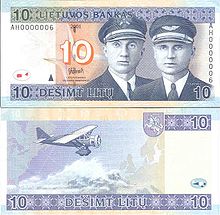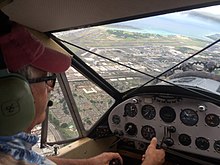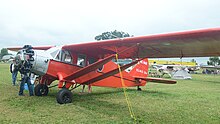Bellanca CH-300 Pacemaker
| CH-300 Pacemaker | |
|---|---|

|
|
| Type: | Light aircraft |
| Design country: | |
| Manufacturer: | |
| First flight: |
1929 |
| Number of pieces: |
about 35 |
The Bellanca CH-300 Pacemaker is a six-seat small aircraft that was primarily built in the United States in the 1920s and 1930s. It is the successor to the CH-200 with a more powerful engine . Like the CH-200, the CH-300 quickly became known for its reliability over long distances.
construction and development
Bellanca developed the CH-300 Pacemaker from the CH-200. It is a stripped high- wing aircraft with a rigid tail wheel landing gear . Like other Bellanca aircraft from this period, the CH-300 also has so-called “flying struts”, which not only support the wings , but also have a profile and thus contribute to the aircraft's lift . While the CH-200 is equipped with a Wright J-5 engine with 220 PS (162 kW ), the CH-300 is powered by a Wright J-6 with 300 PS (221 kW). Towards the end of their production time, some copies were equipped with a Pratt & Whitney Wasp with 420 hp (309 kW), which ultimately led to the development of the CH-400 Skyrocket .
Usage history
Pacemakers were known both for their reliability over long distances and for their high payload capacity, which contributed to their worldwide spread. In 1929, George Haldeman completed the first 1,310 mi (2,108.2 km ) non-stop flight from New York to Cuba in 12 hours and 56 minutes at an average speed of 101.3 mph (163 km / h ). In 1931 Walter Lees and Frederick Brossy set an endurance record with a CH-300 powered by a Packard DR-980 diesel engine . They stayed in the air with their plane for 84 hours and 33 minutes without refueling. That record wasn't broken until 55 years later.
The CH-300 was also very popular in Alaska and Canada . It was first imported to Canada from the USA. Six copies were later built by Canadian Vickers and delivered to the Royal Canadian Air Force , which had already purchased 29 copies in 1929. These machines were mainly used for aerial photography .
In May 1964, Cpt. AGK (Gath) Edward, an experienced Air Canada pilot, and Ken Molson, then curator of the Canada Aviation and Space Museum in Ottawa took the Bellanca Pacemaker with the registration number NC3005 from Juneau , Alaska to the museum that bought the machine. Edward had flown a similar pacemaker seaplane for General Airways since June 1935 . He and Molson returned the plane to its final location in the museum on May 30, 1964 after a five-day, thirty-hour flight. The machine then received the registration CF-ATN, which was originally assigned to another machine in the museum, which was destroyed in an accident in June 1938.
operator
-
 United States
United States
- Civil Aeronautics Authority (5+)
- United States Department of Commerce
- Inter-Island Airways (Hawaiian Airlines)
- Star Air Service
- Vienna Air Alaska
Record attempts
One of the first record flights by a CH-300 took place between July 28 and 30, 1931. Russel Norton Boardman - then 33 - and John Louis Polando - then 29 - flew an early version of a CH-300 powered by a Wright R-975 Whirlwind from Floyd Bennett Field - a popular airfield on western Long Island at the time many record flights began - to Istanbul in Turkey . With their Bellanca Special J-300 with the name "Cape Cod" and the registration number NR761W, they managed the non-stop flight safely in 49 hours and 20 minutes. They set a course record of 5,011.8 mi (8,065.7 km).
On June 3, 1932, Stanislaus F. Hausner tried to fly from Floyd Bennett Field to Warsaw in Poland with his Pacemaker named "Rose Marie", which was powered by a Wright J-6 with 300 hp (221 kW) . Hausner had to ditch the sea and was rescued eight days later by a British tanker .

On July 15, 1933 at 6:24 a.m., the two Lithuanians Steponas Darius and Stasys Girėnas took off from Floyd Bennet Field in a heavily modified CH-300 called Lituanica to fly non-stop across the Atlantic . They successfully crossed the Atlantic but crashed in a forest near Pszczelnik in Poland . An airworthy replica of their machine is on display in the Lithuanian Aviation Museum. The wreck of the Lituanica is in the Vytautas Magnus Military Museum in Kaunas , Lithuania.
Preserved copies
Hawaiian Airlines owns a CH-300 in an airworthy condition. The aircraft was purchased by Inter-Island Airways (renamed Hawaiian Airlines in 1941) and used for sightseeing flights over Oahu for two years before being sold in 1933. In 2009, an aviation enthusiast from Oregon purchased the aircraft and the machine was restored at the Port Townsend Aero Museum . It was unveiled at Honolulu International Airport that same year .
In July 2016, John Pike presented his restored CH-300 at the EAA AirVenture Oshkosh . The machine is the second airworthy specimen.
Another CH-300 Pacemaker is on display in the Canada Aviation and Space Museum . This machine originally flew for Alaska Coastal Airlines .
The Virginia Aviation Museum also has a CH-300, which has been converted into a CH-400 Skyrocket and painted as a WB-2 , which made two groundbreaking flights across the Atlantic.
variants
- CH-300W - CH-300 converted for a Pratt & Whitney R-985 (single copy)
- CH-300-W - Production model with a Pratt & Whitney R-985 (seven copies)
- PM-300 Pacemaker Freighter - Freighter version (two copies)
Technical specifications
| crew | 1 |
| Passengers | 5 |
| length | 27.7 ft (8.4 m ) |
| span | 46.3 ft (14.1 m) |
| height | 8.3 ft (2.5 m) |
| Empty mass | 2,275 lb (1,032 kg ) |
| Max. Takeoff mass | 4,072 lb (1,847 kg) |
| Top speed | 165 mph (266 km / h) |
| Range | 675 mi (1,086 km) |
literature
- Geza Szurovy: Bushplanes . Zenith Press, St. Paul, Minnesota 2004, ISBN 0-7603-1478-0 (English).
- Michael JH Taylor: Jane's Encyclopedia of Aviation . Studio Editions, London 1989, pp. 149 (English).
Web links
Individual evidence
- ↑ 'Cape Cod's' Success Climaxes 5 Years Bellanca Records . In: The Delmarvia Star . Wilmington, Delaware August 2, 1931, p. 6 (English, online [accessed January 30, 2020]).
- ^ The Golden Age of Aviation at Floyd Bennett Field: The 1930s. September 11, 2007, archived from the original on October 26, 2009 ; accessed on May 16, 2009 .
- ↑ a b Randy Dufault: The Only One Flying. EAA AirVenture, July 29, 2016, accessed January 28, 2020 .
- ↑ Deborah Booker: Hawaiian Air's first plane returns. Honululu Advertiser, October 9, 2009, accessed January 28, 2020 .
- ↑ a b Bellanca. Aerofiles, accessed January 28, 2020 .


